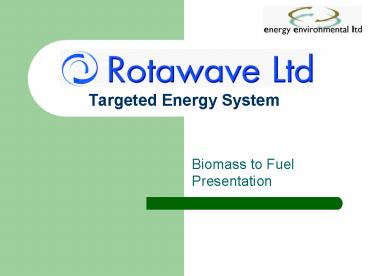Targeted Energy System - PowerPoint PPT Presentation
1 / 20
Title:
Targeted Energy System
Description:
1. Microwaves & 2. Ceramics. Biomass. Water. Microwaves. High Penetration. No contact ... Non Stick Ceramic lifts material away from zero field OHMIC HEATING ... – PowerPoint PPT presentation
Number of Views:33
Avg rating:3.0/5.0
Title: Targeted Energy System
1
Targeted Energy System
- Biomass to Fuel Presentation
2
Contents
- Benefits of Biomass Power Generation
- UK Renewable Demand
- Biomass as Fuel
- Rotawave Microwave Process
- Char Properties
- Plant Details
- Fuel Benefits
3
Benefits of Biomass Generation
4
Sustainable Sourcing
The procurement process has to be designed to
ensure the production and delivery of the biomass
will ? Significantly reduce greenhouse gas
emissions compared to coal-fired generation and
give preference to biomass sources that maximise
this benefit. ? Not result in a net release of
carbon from the vegetation and soil of either
forests or agricultural lands. ? Not endanger
food supply or communities where the use of
biomass is essential for subsistence (for example
heat, medicines, building materials). ? Not
adversely affect protected or vulnerable
biodiversity and where possible we will give
preference to biomass production that strengthens
biodiversity. ? Deploy good practices to protect
and/or improve soil, water (both ground and
surface) and air quality. ? Contribute to local
prosperity in the area of supply chain management
and biomass production. ? Contribute to the
social well being of employees and the local
population in the area of biomass production.
5
Why Power Stations Really Need Biocoal
- Capital Plant
- Existing coal fired generation sets no longer
meet environmental legislation, and will be shut
unless they can be converted. - They need to reduce carbon dioxide (CO2), sulphur
dioxide (SO2), oxides of nitrogen (NOX), hydrogen
chloride (HCl), and particulates (dust) - The cheapest way to convert them is using a
substance which is like coal, but does not have
the same emissions. - Opex
- Typically a power station emits 2.3 tonnes of C02
for every tonne of coal burnt. - With no trading allowance under the ETS scheme
this would cost an extra 220m per year or 0.7p
extra per kWh
6
Problems with Biomass as Fuel
Direct combustion or co-firing
7
Thermal Conversion of Biomass
- Conventional methods of upgrade
- Pyrolysis
- Gasification
- Torrefaction
- Method to increase calorific value
- Low energy input
- High throughput
- Time efficient
- Our alternativemicrowave treatment
8
Technology Basics 5 Innovations
- 1. Microwaves 2. Ceramics
Microwaves High Penetration No contact Selective
hence Low Bulk Temperature No fouling
Water
OHMIC HEATING
Biomass
Non Stick Ceramic lifts material away from zero
field
9
Innovation
- 3. Infra Red, 4. Louvers, 5. Vacuum
Oil Water
Rapid Evaporation from Surface drives diffusion
Infra Red High Energy Low Penetration
10
Advantages of TES
1 De la Hoz A.,Diaz-Ortiz A.,Moreno A.
Microwaves in rganic synthesis. Thermal and
non-thermal microwave effect Chem.Soc.Rev.,2005,
34, 164-178. 2Gronnow M.J., White R.J., Clark
J.H., Macquarrie D.J.Organic Process Research
Development 2005, 9 Issue 4, 516-518.
11
Energy Efficiency
12
Microwave Biomass Process
Biomass
Liquid and Gas by products
Char solid fuel
Microwave treatment
13
Char Properties
Calorific Value (kJ/g)
- Rotawave treatment 160 oC
- torrefaction at 300 oC
- conventional pyrolysis 600 oC
a. Bridgeman, T. G. Jones, J. M. Shield, I.
Williams, P. T., Torrefaction of reed canary
grass, wheat straw and willow to enhance solid
fuel qualities and combustion properties. Fuel
2008, 87, (6), 844-856. b. Michel, R. Mischler
, N. Azambre, B. Finqueneisel, G.
Machnikowski, J. Rutkowski, P. Zimny, T.
Weber, J. V., Miscanthus Giganteus straw and
pellets as sustainable fuels and raw material for
activated carbon. Environ Chem Lett (2006) 4
185189
14
Char Properties
- Calorific Value of coal
- Low ash
- Suitable for TTM
- T180 test
- Bulk Density
- Water proof
- Best Ever Seen!
15
100 Tonne per hour unit
16
Scale of 100 Te/hr Plant
17
Fully Automatic PLC
18
Safety, Control and Software
- Control and Safety
- The process runs on a propriety software
- Fully automatic system
- Safety systems and operating procedures allowed a
safe operation
19
Summary Process Advantages
- Employs highly efficient electromagnetic heating
methods minimising energy usage - Treating Biomass with non-contact microwaves
- Microwave allows high internal temperatures
through Ohmic heating - Providing a very flexible and controllable
continuous thermal process electromagnetic
energy is instantly responsive to the control
system - Occupies a very small foot print the central
processor is smaller than a 40 foot container. - Is an automated system with a low labour
requirements - Sealed system - therefore over coming any exhaust
emission limits
20
Summary Fuel Advantages
- Sustainable
- Low cost of production
- Low mass of ash compared to coal
- Stable fuel (water resistant, no auto-ignition)
- High Calorific value (24-27 MJ/kg)
- Low water content
- Low transport cost per GJ































